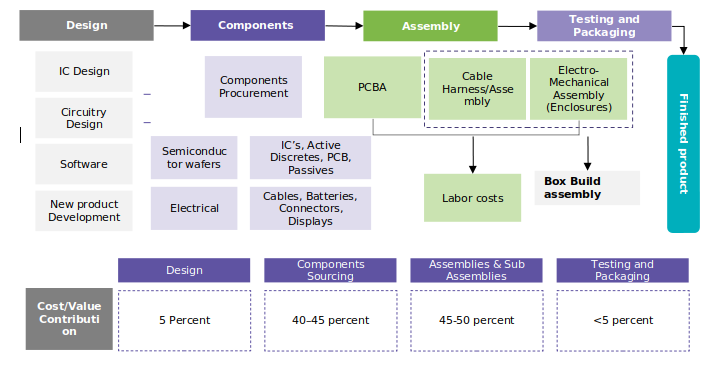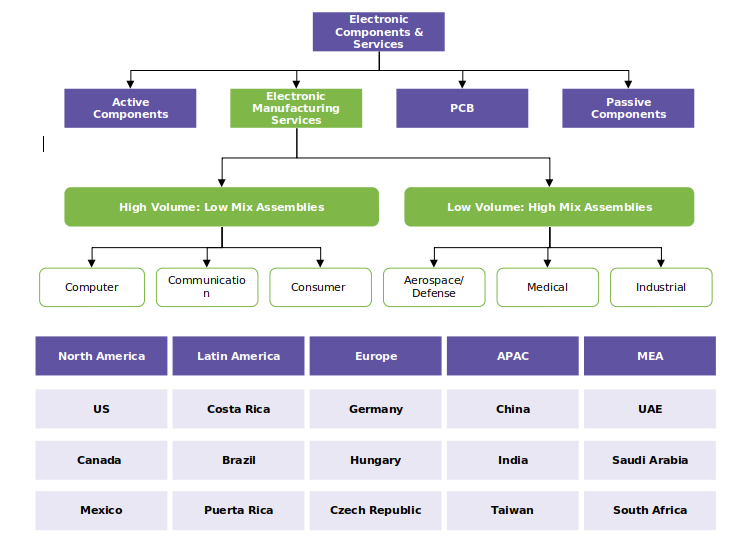Summary Overview
The global Electronic Manufacturing Services (EMS) market is expected to reach USD 758.9 Million by 2025 growing at a CAGR of 8-9% from 2022-2025. Rise in disposable income, increasing demand from Communication, Computer, Consumer sectors are primarily driving the market demand for EMS
EMS Market Outlook
Consumer demand is witnessing continuous weakening trend since the beginning of Q1’22. However, there exists strong demand for EMS services from other end markets like Automotive, Communication, Medical majorly supported by Electrification of vehicles, Integration of Automation in industries, IoT, Artificial intelligence etc.,
APAC dominated the global market constituting a major proportion of 70 percent, supported by domestic demand, supply of feedstock and components, and low-cost advantages.
Weakening demand from consumer, computer, telecom directly impact the pricing state of EMS market despite the propulsive demand from automotive, medical markets.
Strong demand from different end markets is driving the market competition, and the suppliers are also continuously upgrading their technical and operational capabilities to lead the market position
The trend towards miniaturization demands for increasing complexities in the electronic assembly, such as higher component density, multiple layers, smaller pitches, delicate parts, and precise placements, and hence, promoting continuous product innovations and thus driving EMS market. E.g., Mobile Phones, Storage devices, etc.
COVID-19, and Economic Headwinds Impact on EMS market.
During the pandemic situation, most of the industries were exposed to supply chain risk on account of sourcing problems, labor shortage and logistics issues. Considering this, the companies have realigned their strategies to look for domestic sourcing alternatives and they tend to go with diversification of supply base to mitigate the supply chain risks
EMS Pricing Insights
Raw materials are one the major price driver for the EMS market. Despite the volatility in raw material prices, EMS prices is currently driven by supply demand dynamics as the market experience demand dropdown from significant downstream markets like Consumer, Computer, Communications etc., Thus, the prices are expected to witness stable or marginal decreases owing to the weakening consumer demand because of the globally increasing inflation rate.
EMS Supply Outlook
Electronic manufacturing services supply base is highly fragmented with suppliers serving to multiple industries such as Computers and Peripherals, Communication and Telecom, Consumer, Automotive etc., Supply base concentration is found to be relatively higher in Asian countries specifically China, India, and other southeast Asian countries. Earlier EMS providers catered only for PCBA services; however, their role has expanded to provide complete end to end support for OEMs starting from design phase, prototype development, assembly, testing and validation, packaging and after sales support.
EMS Value Chain 
Regional Market Insights
APAC dominated the global market constituting to a major proportion of 70 percent, supported by domestic demand, supply of feedstock and components, and low-cost advantages. Also, APAC dominates high volume electronics assembly in markets such as Computer, Consumer, Telecom etc., The recent COVID flare up in China and in reflection the ZERO COVID Policy is significantly hindering the production output and in turn forcing OEMs to develop contingency plans to relocate the production bases to nearby locations like Malaysia, Vietnam, India, or locations like Mexico closer to developed markets.
US EMS manufacturing is dominant for high-mix low-volume markets, such as aerospace, defense, and medical markets, considering the strength of high-skilled R&D team, supported by incorporation of high-end technologies in the manufacturing space
EMS revenue in Western Europe is expected to increase, as the market is increasingly focused on end-use industries, like aerospace, defense, automotive, medical, control and instrumentation, industrial telecom segments
Supplier Intelligence
The category intelligence covers some of the key global players such as Foxconn (Hon Hai Precision Industry), Sanmina, Pegatron, Jabil and Flextronics.
Key global players have announced the reduction of carbon footprint as part of their sustainable strategies. For instance, Hon Hai is adopting United Nations sustainability goals through Sustainable Strategy, Circular Economy, and Zero Waste Management. As part of this, the company adopts lead-free and halogen-free manufacturing processes in their daily operation
Segmentation Overview:








